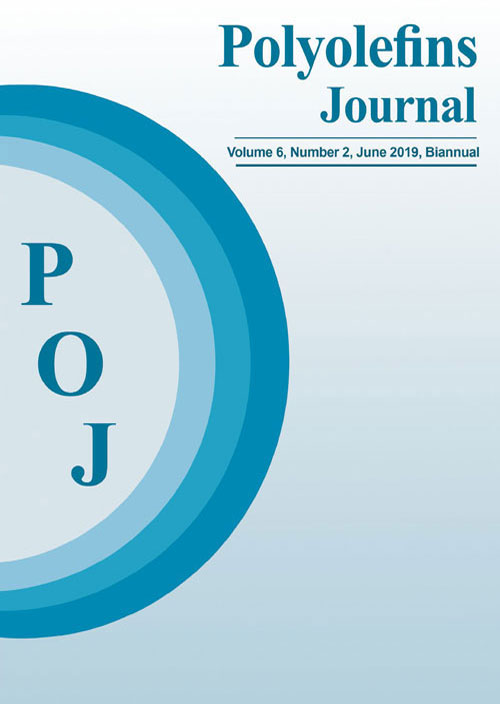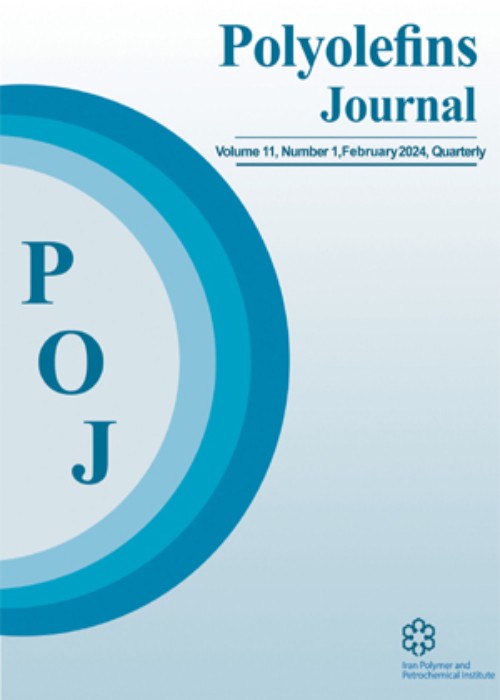فهرست مطالب

Polyolefins Journal
Volume:8 Issue: 2, Summer-Autumn 2021
- تاریخ انتشار: 1400/04/27
- تعداد عناوین: 7
-
-
Pages 63-72
Laboratory runs can be minimized via experimental design which yields the optimum and best data regarding the independent parameters. In this research work, response surface methodology (RSM) based on a threelevel central composite design (CCD) was utilized to optimize and evaluate the interactive effects of processing conditions for polymerization of 1,3-butadiene (Bd) diene monomer using Ziegler-Natta catalyst. The polybutadiene rubber (PBR) having different cis content and molecular weight was obtained. The catalyst components included neodymium versatate (NdV3) as catalyst, triethyl aluminum (TEAL) as cocatalyst or activator, and ethylaluminum sesquichloride (EASC) as chloride donor. For the modeling, three independent variables, namely monomer concentration (8-28 wt%), reaction time (1.5-2.5 h), and reaction temperature (45-75ºC) at three levels were selected to optimize the dependent variables or responses including monomer conversion, viscosity-average molecular weight and the cis isomer content of the obtained polymer. The interaction between three crucial parameters was studied and modeled. Quadratic models were obtained to relate process conditions to dependent variables. It was observed that the optimal conditions predicted by RSM were consistent with the experimental data. Statistical analysis demonstrated that concentration of the monomer and the time of reaction significantly affected cis content. Moreover, processing conditions to achieve the desired response variables were predicted and experimentally approved. The optimal reaction conditions derived from RSM are monomer concentration = 19 wt%, polymerization time = 2 hours, and polymerization temperature = 50ºC. Polymerization was carried out at optimum conditions. The appropriate level of dependent variables including 94.2% monomer conversion, 151812 g/mol viscosity-average molecular weight and 98.8% cis content was acquired.
Keywords: Ziegler-Natta, polybutadiene rubber, Processing conditions, Neodymium versatate, Response surface method -
Pages 73-84The influence of long branches on crystallization behavior has been studied by means of molecular dynamics simulations. Using two systems: polyethylene (PE) with long branches (LCB-PE) and PE without long branches (linear-PE) with the same molecular weight, we have examined the crystallization behavior of the two systems by molecular dynamics simulation. This paper explains the influence of long branches on the isothermal crystallization process and the non-isothermal crystallization process with similar initial interchain contact fraction (ICF) in terms of final ICF, crystal regions, crystallinity, concentration of tie chains and energy. It is found that the crystallization process is classified as two stages: the nucleation stage and the crystal growth stage. The existence of long branches is favorable for the first stage while unfavorable for the second stage. Knots that act as crystalline defects are excluded from the lamella, resulting in decreasing in regularity and crystallinity of molecular chains. From the perspective of potential energy and non-bond energy, LCB-PE has lower energy than linear-PE in the nucleation stage while the energy of linear-PE is lower than that of LCB-PE in the second stage. In short, the long branched chains inhibit the crystallization process.Keywords: molecular dynamics, crystallization, long branches, nucleation, tie chains
-
Pages 85-91The present paper systematically studies the homo- and copolymerization of ethylene or propylene using metallocene as catalyst and diethyl zinc as chain transfer agent to obtain the polyolefin waxes with narrow molecular weight distribution and with a high activity. The molecular weight of the resultant polymer could be controllable by the concentration of diethyl zinc quantitatively. The introduction of a-olefin into the ethylene polymerization system would shield the chain transfer action, and the shielding effect in propylene (co) polymerization is more serious, due to the mass transfer resistance of the substituents on the monomers. Branched comonomer and long chain comonomer provide stronger shielding effect. The regression results show that the order of the chain transfer reaction of propylene polymerization is smaller than that of ethylene polymerization, and the order of the chain transfer reaction of copolymerization is less than that of homopolymerization. It indicates that the substituent on the monomer would result in the deviation of the regression data from the ideal primary reaction order.Keywords: metallocene catalysts, olefin polymerization, chain transfer, diethyl zinc, molecular weight
-
Pages 93-103Methanol dehydration is a high potential route for the production of light olefins (C2-C4). In this study, hierarchical Si-rich [B]-ZSM-5 catalysts (Si/Al= 200) were prepared through one-pot hydrothermal synthesis, including boron as a promoter and ethanol as a low-cost secondary template. N2 adsorptiondesorption, XRD, FE-SEM, and FT-IR techniques were applied to characterize the catalysts. The effect of different amounts of ethanol and different operating conditions was studied on the ZSM-5 catalyst preparation and performance in methanol-to-olefins (MTO) reaction. The results showed that the optimum amount of ethanol (ethanol/TPABr=5) led to the highest crystallinity (91.2%), the highest specific surface area (>400 m2g-1), and total pore volume (0.19 cm3g-1). The best catalytic performance was obtained at temperature of 480°C and methanol hourly space velocity (WHSV) of 7.2 h-1. The optimum catalyst had the highest propylene selectivity (58%) and light olefin selectivity (85%). The results proved the high capability of the new strategy for the efficient and fast development of the MTO catalyst.Keywords: Methanol to olefin, ZSM-5, dual template, ethanol, catalyst
-
Pages 105-113The research was carried out in a large-scale olefin process to see how different variables affect ethylene yield in an actual fluctuating plant condition. Regression analysis was adopted using Minitab Software Version 18 to create a reliable ethylene yield model. Regression analysis is a robust, practical, and advanced tool that is used in various applications as an alternative to the complex, expensive, and restricted simulation software that is specifically designed for the olefin process. The 1688 data taken from the studied plant underwent outliers and residuals removal utilizing normality and stability tools in Minitab for the analysis to be conducted as normal data. The Regression was conducted a few times until all variables satisfactorily met the multicollinearity criteria with Variance Inflation Factor (VIF) < 10 and 95% confidence level criteria with P-Value < 0.05. The final Regression model established 4 significant variables which were Hearth Burner Flow, Integral Burner Flow, Super High- Pressure Steam (SHP) Temperature, and Naphtha Feed Flow by factors of -0.001266, 0.04515, -0.0795, and 0.2105, respectively. The maximum ethylene yield was calculated at 31.75% using Response Optimizer with the recommended operating conditions at 9908.50 kg/h Hearth Burner Flow, 600.39 kg/h Integral Burner Flow, 494.65°C SHP Temperature, and 63.50 t/h Naphtha Feed Flow.Keywords: Olefin yield, steam cracker furnace, optimization, statistical analysis, minitab
-
Pages 115-122Elastomer vulcanizates based on natural rubber (NR), NR reclaim (NRR) and layered silicates were compounded in an internal mixer and cured on a two-roll mill. Cure characteristics and mechanical properties of samples based on 50NR/50NRR reinforced with Cloisite 20A, Cloisite 30B and Nanolin DK1 were compared to those of conventional NR/NRR/kaolin microcomposites. Due to the light/soft nature of organoclays suppressing the friction forces, the minimum torque values decreased in the presence of organoclays, whereas the crosslink density, evidenced by the difference between the maximum and minimum torque values, increased in all samples and scorch times shortened by 37% to a minimum in the presence of Nanolin alkaline/catalytic role in the cure reaction. Fatigue resistance improved by about 10% benefiting the crack tips blunting/energy consuming hysteresis mechanisms motivated by the organoclays among which Nanolin DK1 provides the most efficient dispersion/distribution of nanolayers by faster intragallery crosslinking reactions that pushes the stacks apart. Higher states of dispersion in this sample would also promote strain-induced crystallization under deformation responsible for the improvements seen in the modulus and elongation-at-break. Two-step mixing sequence further improved the compound performance due to the dispersion state progress confirmed by X-ray diffraction and transmission electron microscopy (20% in fatigue resistance and 53% in tensile modulus). In-situ compatibilization through bis(triethoxysilylpropyl)tetrasulfide bi-functional silane coupling agent also promoted modulus and fatigue resistance. However, a prolonged scorch time was observed due tothe blinded NR cure-reactive sites as well as steric hindrance of large functional groups in the presence of this coupling agent.Keywords: NR, Reclaimed NR, oganoclay, Mixing sequence, Coupling Agent
-
Pages 123-133Bulk phase polymerization of propylene with a 4th generation of Ziegler-Natta catalyst was kinetically investigated by means of heat flow calorimetry. The assumptions and modifications on isothermal calorimetric method were demonstrated. Our calibration method showed that heat exchange with the reactor cover plate is not constant over time. Therefore, the dynamic of cover plate temperature was considered in the calorimetric method. The polymerization rate profiles depending on hydrogen and external electron donor concentration have been investigated. Normalized polymerization profiles (Rp /Rpmax) are plotted and expressed as an exponential function of time. Effects of hydrogen and external electron donor (ED) concentration on Rpmax and polymerization rate were investigated as well. The results showed that by increasing hydrogen concentration, initial polymerization rate (Rpmax) increased. Hydrogen increased productivity by increasing the initial polymerization rate, while it had no negative effect on the rates of decay or its effect was small. The ED concentration was optimized so that the catalyst deactivation rate was at its lowest level. Also, changes in the ratio of activation to inactivation with ED concentration were examined, and a proportional change was observed.Keywords: kinetic study, calorimetry, liquid monomer, Propylene, polymerization


